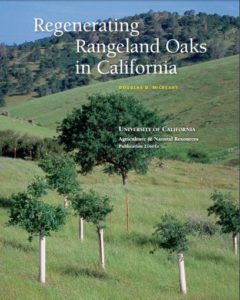Oak Woodland Articles
In addition to the Newsletter Oaks ‘n Folks, UC’s Integrated Hardwood Range Management Program produced a wide range of publications during the 24 years it was in existence. These included Proceedings of Oak Symposia that were held every 5-6 years (links at the bottom of this page), refereed research publications resulting from scientific studies, and an assortment of targeted brochures, pamphlets and books that addressed some particular aspect oak woodland management or ecology. Here is comprehensive list of IHRMP Oak Research Publications.
The following publications are either available for purchase from UC Agriculture and Natural Resources or can be downloaded for free; see each listing for information. Click here to browse the UC Agriculture and Natural Resources Bookstore.
Economic Contribution of California’s Forestry and Forest-Products Sectors
This 17 page article is a UC Agriculture and Natural Resources publication and is available for download. By Richard Standiford, Sanuel Evans, James Henderson |
Natural History of the Central Coast Bioregion
This publication provides an overview of the geology, climate, water resources, flora and fauna, human history, ecosystem services, and natural resource management issues associated with human development of California’s Central Coast. It also provides an increased understanding of the Central Coast’s natural communities and the conservation challenges presented by exurban development, agricultural expansion, and climate change. Part of the California Naturalist Series, this 48 page natural history was published in July 2019 by UC Agriculture and Natural Resources and is available for download. By William D. Tietje, Environmental Science, Policy, and Management, University of California, Berkeley; William L. Preston, Geographer Emeritus, California Polytechnic State University, San Luis Obispo; Anne Y. Polyakov, Environmental Science, Policy, and Management, University of California, Berkeley. |
A Planner’s Guide for Oak Woodlands
Chapters cover a range of planning and conservation topics including —
The 116-page second edition also features a sturdier binding and more photographs. The encroachment into oak woodlands addressed at the time of the first edition has not stopped, and in some cases it has continued at an alarming rate. As more development occurs in the oak woodlands this guide can provide a framework for preserving this icon of the California landscape. Available for purchase from University of California Agriculture and Natural Resources bookstore. |
Living Among the Oaks
One of the most popular IHRMP publications has been a glossy 8-page color brochure that, among other things, contains specific information about how to manage native California oaks in an urban setting. This publication contains helpful tips about how to prevent damage to oak roots, where and when to irrigate around oaks, what plants are best to plant near oaks, and what to do if a tree has been damaged by fire. Available for free download from University of California Agriculture and Natural Resources bookstore. |
Guidelines for Managing California’s Hardwood Rangelands |
How to Grow California Oaks
It is estimated that one or more species of oaks grow on over 20 percent of the state’s 100 million acres of land. Unfortunately, there are also reports that some native oaks may not be regenerating very well in some locations. Poor natural regeneration raises concerns about the long term fate of these species. To assist Mother Nature in establishing new oak trees, efforts are underway to plant acorns and small seedlings. Such regeneration efforts will ensure that our magnificent oaks, which have graced California valleys and foothills for thousands of years, will be around for future generations to enjoy also. These guidelines provide successful techniques for growing oak trees. While there are many ways to get an oak tree started, the procedures described have proved successful for a variety of species and environments. By Douglas D. McCreary, Natural Resource Specialist, UC Sierra Foothill Range Field Station. Free publication that you can download. |
Regenerating Rangeland Oaks in California
Included are chapters on poor natural regeneration and conditions under which this problem seems most acute; acorn physiology; collection and storage of acorns for regeneration; oak seedling propagation; and planting, protecting, and maintaining oak seedlings in the field. This revised electronic publication replaces the previous print edition, Regenerating Rangeland Oaks in California (Publication 21601). Free publication that you can download. |
Oak Woodland Invertebrates: The Little Things Count
Among the invertebrate animals explored in this publication are the California Oak Worm, the Filbert Weevil and the Filbert Worm, and the Tarantula Hawk. Also explored is the human impact on this delicate ecosystem. This is an excellent learning tool for anyone who cares about our California Oaks and wants to know more about this important ecosystem. This is a scan of the original print publication that you can now download for free. |
|
Oak Research Symposia
Download free copies of the 7 proceedings
- June 26-28, 1979; Claremont, CA; Proceedings of the symposium on the ecology, management, and utilization of California oaks – USDA Forest Service PSW-GTR 44
- November 12-14, 1986; San Luis Obispo, CA; Proceedings of the Symposium on Multiple-Use Management of California’s Hardwood Resources – USDA Forest Service PSW-GTR 100
- October 31 – November 2, 1990; Davis, CA; Proceedings of the symposium on oak woodlands and hardwood rangeland management – USDA Forest Service PSW-GTR 126
- March 19-22 1996; San Luis Obispo, CA; Proceedings of a symposium on oak woodlands: ecology, management, and urban interface issues – USDA Forest Service PSW-GTR 160
- October 22-25, 2001; San Diego, CA; Proceedings of the fifth symposium on oak woodlands: oaks in California’s changing landscape – USDA Forest Service PSW-GTR 184
- October 9-12, 2006; Rohnert Park, CA; Proceedings of the sixth California oak symposium: today’s challenges, tomorrow’s opportunities – USDA Forest Service PSW-GTR 217
- November 3-6, 2014; Visalia, CA; 7th California Oak Symposium: Managing Oak Woodlands in a Dynamic World – USDA Forest Service PSW-GTR 251
- October 31 – November 3, 2022; San Luis Obispo; 8th California Oak Symposium: Sustaining Oak Woodlands Under Current and Future Conditions (Proceedings Available Soon)









